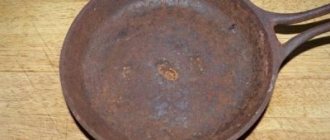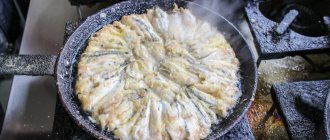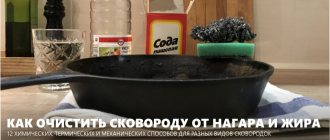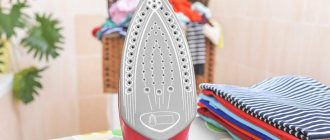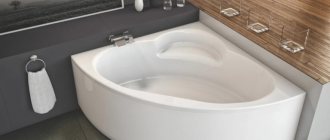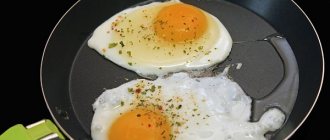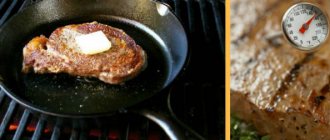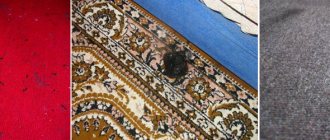Many housewives prefer to use a frying pan with a ceramic coating. This is explained by the fact that it has a number of advantages over kitchen utensils made from other materials.
The main advantages of a ceramic frying pan:
- the surface is heated evenly;
- the manufacturing material is considered environmentally friendly, capable of preserving all the beneficial properties of food;
- You can cook on it using a small amount of oil, food in such dishes does not burn;
- Unlike cast iron and Teflon cookware, ceramic products can be any color.
Like any thing, a frying pan with a ceramic coating also has its disadvantages :
- it does not tolerate strong temperature changes;
- subject to mechanical stress;
- susceptible to soot formation.
But the latter can hardly be considered a serious drawback, because carbon deposits can be removed independently. The following will describe how to clean a ceramic-coated frying pan at home. By the way, these methods can also be used to clean other ceramic dishes and dishes with Teflon coating: pots, roasting pans, baking sheets, etc.
Melamine sponge
Melamine sponge has become popular recently. It is considered the number one remedy in the fight against various contaminants that even household chemicals cannot remove.
A melamine sponge resembles a regular eraser; its fibers are very flexible, which allows you to clean dirt even from ceramic surfaces without damaging it. This product is a great help when you don’t want to use chemical cleaners.
A pot or pan can be easily cleaned at home with a melamine sponge.
Application:
- Put on gloves and cut off a small piece. Thus, the consumption of melamine sponge will be more economical.
- It is moistened with warm water, lightly squeezed, pressing it on both sides with your palms. The sponge should not be crumpled; it may break at the bends when cleaning the pan.
- The pan should be cleaned without adding any products, even folk ones. When interacting with melanin, substances hazardous to health can be released.
- Cleaning the pan is done with the edge of a sponge. If you apply it entirely to the soot, it will crumble.
After removing the fat, the kitchen utensils are rinsed with water. This is necessary to remove any remaining microscopic substances.
Rules for caring for ceramic frying pans
If the operating rules are followed, the original properties of the product are preserved for a longer period. The basic rules of use include the following:
- It is better to wash ceramic dishes using gentle products. Do not use baking soda or other abrasive cleaners as this may damage the surface. The frying pan can only be cleaned using gentle methods;
- When cooking, you should not use an iron spatula; it can cause damage to the surface. It is better to give preference to blades made of wood or silicone;
- You cannot use the cookware immediately after purchase. It is washed and dried. Then rinse with water and wipe with a lint-free cloth;
- When cooking, it is recommended to use a minimum amount of oil. It is enough to lubricate the surface with a cloth soaked in oil;
- Do not change the temperature too suddenly. If a hot product is immediately placed under cold water, the ceramic layer may deteriorate. Therefore, if the pan needs to be cooled, do it slowly;
- After cooking, do not leave dishes in the sink for a long time. After soaking, it is necessary to immediately wash it in the usual way. After this, the surface is thoroughly wiped;
- After preparing food, do not put the dishes aside. It is better to clean it immediately after it cools down. The sponge must be moistened and wiped. This manipulation helps prevent the further appearance of plaque.
Getting rid of carbon deposits on a frying pan is not so difficult, but it is better to just follow the rules for using the frying pan. Only in this case will the dishes last a long time.
Milam gel
Milam gel detergent is used to care for stoves, ovens, enamel sinks, pots and ceramic frying pans.
Its use is only possible with personal protective equipment, which includes a mask and rubber gloves. The substance is caustic and may burn skin.
How to clean a ceramic frying pan:
- Shake the bottle of gel before use.
- Apply to surface for 5-10 minutes. If that doesn't help, scrub with a sponge.
- After the procedure, rinse with water.
Milam gel can be used for cast iron, non-stick and stainless steel products. But it cannot be used to clean aluminum cookware.
Thanks to Milam gel, it will be easier to achieve cleanliness without the fear of scratching the shiny surface.
Is it worth washing the device?
How to clean pans? If light stains occur, rinse the product in water. But it is important that there are no sudden temperature changes.
If light contamination occurs, rinse the ceramic frying pan in water.
If large stains have formed, it is better to wash the pan in a gentle way. To do this, first soak the dishes and then wipe them with a soft sponge with the addition of a cleaning agent. It is important to consider that ceramics are vulnerable to high temperatures. Therefore, before soaking a ceramic product, you need to wait until it is completely dry. Otherwise, small cracks may form on the ceramic surface. This will further provoke the loss of non-stick properties.
Fresh carbon deposits are removed after pre-soaking in water with a drop of cleaning agent
Alcohol or vodka
After cooking food in sunflower oil, brown or brown spots remain on the bottom of the pan. It almost always burns when frying cutlets or steaks, which causes unnecessary trouble.
Proper care of ceramic cookware is sometimes not enough. After all, to put the product in order after using sunflower oil, you may need heavier artillery.
How to clean a ceramic frying pan?
Ammonia or rubbing alcohol will help successfully remove brown stains. And you can replace them with regular vodka.
To remove burnt marks from a ceramic surface, soak a cotton swab in alcohol and wipe the dirty area several times. The fat will begin to dissolve before your eyes.
This detergent can remove even difficult stains without using household chemicals.
Criterias of choice
- The wall thickness of a quality product should not be less than 4 mm - this condition prevents deformation of the sides when heated. And the bottom should be even thicker
- A good frying pan should be felt in your hand, no matter how you look at it
- The mandatory presence of certificates and warranty cards is a guarantee of the authenticity of the product and a guarantor of its safety. That is why give preference to well-known brands and do not skimp on healthy eating
From everything it is clear that frying pans with non-stick ceramic coating are a necessary and almost irreplaceable thing in every kitchen. And all because this product consists of continuous advantages and has no disadvantages. Although there is one thing - this is that with such a frying pan you will spend even more time in the kitchen to please your loved ones with delicious dishes. Although this is rather another advantage! After all, cooking in pans from the Grand Lux store is a pleasure and benefit. Return to list
Water, sponge and detergent
Regular dishwashing detergent is the most common way to remove stains from kitchen utensils.
But this option is relevant for fresh contaminants that have not yet become embedded in the surface structures. After using ceramic dishes, immediately fill them with hot water and add detergent.
Then the housewife needs to leave the frying pan for a while so that all the burnt food soaks and moves away from the walls on its own. Residues are removed with a sponge.
How to descale a ceramic frying pan
Poor quality water causes scale to form on ceramic dishes. This happens especially often if the housewife likes to stew food. You can get rid of this using ordinary onions, kefir or tooth powder.
- For the first method, you will need a regular onion, peeled. It is cut into several pieces and boiled in a frying pan. Then leave the dishes with onion broth for 5 hours.
- In the second method, kefir is used. It is enough to rinse the dishes well and pour kefir into them. Its oxidizing properties will help get rid of rust.
- For the third method you will need tooth powder. The powder is mixed with a gentle detergent and foamed with water. You cannot rub this mixture into the dishes; just pour the solution into it. The equipment is left for 3 hours.
Scrapers with metal bristles should not be used.
Digestion
Boiling is suitable for any type of pan. It copes with the task perfectly and effectively removes any contaminants.
To boil ceramic kitchen utensils you will need:
- 500 grams of baking soda;
- bar of 72% laundry soap;
- 2 bags of silicate glue.
To carry out the procedure, also prepare a large container so that the frying pan can fit into it.
Digestion algorithm:
- A sufficient amount of water is placed on the fire and heated. Add grated soap, then soda and glue. All components must be completely dissolved.
- The frying pan is placed in a boiling container, brought to a boil and left on the fire for 15 minutes. After boiling, the kitchen utensils are left in the water for another 2 hours.
- At the end of the procedure, wash the pan with a sponge.
To remove carbon deposits from ceramic dishes, you cannot use a metal scraper; it leaves scratches on the surface.
How to remove burnt oil?
How to clean dishes from burnt vegetable oil
- prepare a mixture of baking soda with the addition of hydrogen peroxide;
- apply the mixture to areas contaminated with grease;
- let the dishes with the applied mixture stand for 40 minutes;
- remove grease using kitchen sponges;
- Rinse the dishes under running water.
21 Jan
2022 Interesting materials:
How to care for jasmine in the garden? How to install laminate flooring in a long room? How to root apple tree cuttings? How to root juniper cuttings? How to root blackberries using cuttings? How to root herbaceous hibiscus? How to boil a kettle with vinegar? How to improve the sound quality during a conversation? How to improve a small kitchen? How to improve relationships in Mount and Blade Warband?
Dishwasher
Ceramics can be placed in the dishwasher. This will take less time and reduce financial costs.
For ceramic material, the maximum washing mode is set. The detergent you choose is liquid or gel; you can also purchase special gel capsules.
However, one cycle may not be enough; the procedure will have to be repeated if the food is severely burned. Caring for a ceramic frying pan is easier and easier this way, and you will have extra time to do other household chores.
Activated carbon
Activated carbon is an excellent absorbent, which is used not only in medical practice. Take 20–15 tablets of the black drug and grind it into a powder.
Rinse the pan with water and cover the entire bottom with dishwashing detergent. Rub the gel into an even layer, and sprinkle crushed activated carbon on top of it.
After 1 hour, rinse everything off with warm water, if necessary, rub the stain with a sponge or repeat the manipulation with the tablets.
Loofah and citric acid
Burnt food can be easily removed from ceramic coatings using regular citric acid. But it will take more effort.
The sponge can be hard: foam rubber or polyurethane, but not metal.
How to clean a ceramic frying pan:
- The frying pan is filled to the very brim with warm water and placed on the fire.
- When the liquid becomes hot, add vinegar or a packet of citric acid.
- After the water boils, remove the pan from the stove and allow to cool.
- Vinegar and citric acid soften and loosen burnt-on food residues, making them easier to remove with a dishwashing sponge. It is better to take apple cider vinegar; it is completely harmless. You cannot add soda, since this substance is detrimental to ceramics; after its exposure to the product, it will completely lose its non-stick properties.
- To improve fat cleaning, use detergent.
This method of cleaning a frying pan is suitable if the problem has not yet started. In more severe cases, citric acid and vinegar will not help.
How not to clean a frying pan with a ceramic coating
Ceramic coating is quite vulnerable. Cleaning dishes is prohibited using the following methods:
- Hard brushes;
- Metal washcloths;
- Melamine sponges;
- By calcination;
- Compositions that contain abrasive particles.
The ceramic coating of the frying pan is quite vulnerable.
You also cannot use these methods:
- Boiling soda method. This method completely neutralizes carbon deposits, but destroys the coating;
- Glue treatment. After such exposure, a sticky residue may remain on the pan, which is difficult to remove.
